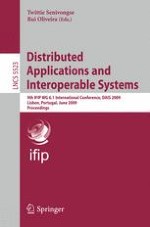This book constitutes the refereed proceedings of the 9th IFIP WG 6.1 International Conference on Distributed Applications and Interoperable Systems, DAIS 2009, held in Lisbon, Portugal, in June 2009. The DAIS conference was held as part of the federated event on Distributed Computing Techniques (DisCoTec), together with the 11th International Conference on Coordination Models and Languages (Coordination 2009) and the IFIP WG 6.1 International Conference on Formal Techniques for Distributed Systems (FMOODS/FORTE 2009). The 12 revised full papers presented were carefully reviewed and selected from 32 submissions. The papers address service orientation, quality of service and service contract, business processes, Web services, service components, algorithms and protocols supporting dependability, fault tolerance, data replication, group communication, adaptive and collaborative systems, context awareness, model-driven development, middleware for ubiquitous computing and sensor networks, ad hoc network protocols, peer-to-peer systems, and overlays. They are organized in topical sections peer-to-peer networks, adhoc networks, dependability, and infrastructure and services.
